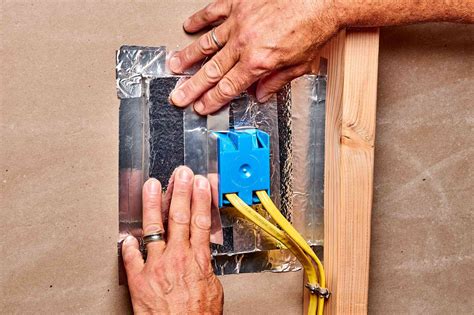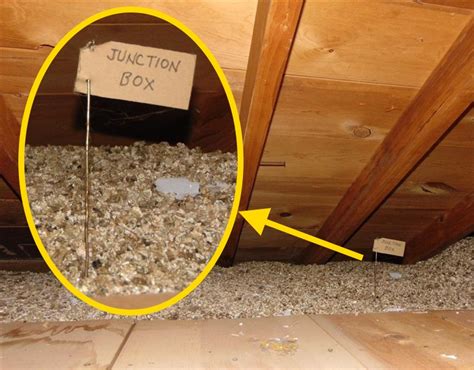blown in insulation around electrical boxes Are there any restrictions on blowing cellulose insulation into an attic and burying the cable and junction boxes? A. Lynn Underwood, a licensed contractor and building code . ZINUS 9 Inch Metal Smart Box Spring, Mattress Foundation, Strong Metal Frame, Easy Assembly, Full. Visit the Zinus Store. 4.5 81,822 ratings. Amazon's Choice. 50+ bought in past month. $14705. FREE Returns. Coupon: Apply $22.06 coupon Terms.
0 · insulation for junction boxes
1 · insulation for attic junction boxes
2 · insulation for attic boxes
3 · electrical boxes in insulation
4 · can you insulate junction boxes
5 · can you bury electrical boxes
6 · can electrical boxes be insulated
7 · buried electrical boxes in insulation
Close by you will find a room containing both a CCTV junction box and a new weapon-a carbine. After scanning the CCTV and acquiring the weapon, be prepared to confront more zombies that emerge. Dispatch them and continue your journey.

This book had the exact reference I was looking for, saying this about electrical boxes: “ They can be buried inside insulation provided it can be removed to access the box. Foamed-in-place insulation should not cover a box.” The trusses and joists are all open and there is blown in insulation up to the height of the joists. In the future I need to have more insulation installed. Is it safe (up to code) to . Can you lay insulation over electrical wires in the attic? Yes, you absolutely can. You can lay insulation around the junction boxes as well. Making sure that the insulation is of a .
Are there any restrictions on blowing cellulose insulation into an attic and burying the cable and junction boxes? A. Lynn Underwood, a licensed contractor and building code . Insulating your attic can significantly decrease your heating and cooling costs. However, blown insulation can create a fire hazard if it comes in contact with electrical fixtures. . Blown-in insulation fills between existing wall studs and ceiling joists quickly and easily. During new construction, batt insulation—thick strips of spun fiberglass or a paper-based.
This book had the exact reference I was looking for, saying this about electrical boxes: “ They can be buried inside insulation provided it can be removed to access the box. Foamed-in-place insulation should not cover a box.” The trusses and joists are all open and there is blown in insulation up to the height of the joists. In the future I need to have more insulation installed. Is it safe (up to code) to cover the junction boxes with more insulation or is this considered concealing them?
The small air gaps around electrical boxes on exterior walls and ceilings leak more air than you might imagine. Achieve better foam outlet insulation with these simple tips. “Junction boxes can be covered by insulation in such a manner that it can be removed without damaging it to access the box. Foamed-in-place insulation isn’t removable and therefore not permissible.” Q: I know that knob-and-tube wiring can't be covered with insulation, but what about BX cable and joist-mounted junction boxes? Are there any restrictions on blowing cellulose insulation into an attic and burying the cable and junction boxes?
insulation for junction boxes
Can you lay insulation over electrical wires in the attic? Yes, you absolutely can. You can lay insulation around the junction boxes as well. Making sure that the insulation is of a fiberglass material will not only ensure a fireproof setup but also reduce airflow from the home through the attic. Insulating your attic can significantly decrease your heating and cooling costs. However, blown insulation can create a fire hazard if it comes in contact with electrical fixtures. The rules regarding insulation in the National Electrical Code do not specify what type of protection must be provided. Blown-in insulation fills between existing wall studs and ceiling joists quickly and easily. During new construction, batt insulation—thick strips of spun fiberglass or a paper-based. Covering boxes with blown in insulation passes inspection here (VA and MD) just fine. FWIW, I first encountered this restriction in Maryland - the Baltimore electrical inspector rejected a job where the junction boxes had been covered.
Also consider using blown in insulation, fiber glass Batts only meet their performance if they are installed perfectly, blown in insulation gives you full coverage and will also cover the joists to reduce thermal bridging. This book had the exact reference I was looking for, saying this about electrical boxes: “ They can be buried inside insulation provided it can be removed to access the box. Foamed-in-place insulation should not cover a box.”
The trusses and joists are all open and there is blown in insulation up to the height of the joists. In the future I need to have more insulation installed. Is it safe (up to code) to cover the junction boxes with more insulation or is this considered concealing them?
The small air gaps around electrical boxes on exterior walls and ceilings leak more air than you might imagine. Achieve better foam outlet insulation with these simple tips. “Junction boxes can be covered by insulation in such a manner that it can be removed without damaging it to access the box. Foamed-in-place insulation isn’t removable and therefore not permissible.” Q: I know that knob-and-tube wiring can't be covered with insulation, but what about BX cable and joist-mounted junction boxes? Are there any restrictions on blowing cellulose insulation into an attic and burying the cable and junction boxes?
Can you lay insulation over electrical wires in the attic? Yes, you absolutely can. You can lay insulation around the junction boxes as well. Making sure that the insulation is of a fiberglass material will not only ensure a fireproof setup but also reduce airflow from the home through the attic. Insulating your attic can significantly decrease your heating and cooling costs. However, blown insulation can create a fire hazard if it comes in contact with electrical fixtures. The rules regarding insulation in the National Electrical Code do not specify what type of protection must be provided.
Blown-in insulation fills between existing wall studs and ceiling joists quickly and easily. During new construction, batt insulation—thick strips of spun fiberglass or a paper-based. Covering boxes with blown in insulation passes inspection here (VA and MD) just fine. FWIW, I first encountered this restriction in Maryland - the Baltimore electrical inspector rejected a job where the junction boxes had been covered.
insulation for attic junction boxes

electrical box switch per outlet
electrical box trim rings
The best box spring should be flat, level, and built to keep your mattress in tiptop shape; and that’s just what the Smart BoxSpring® does! With its reliable steel structure, you can rest assured that your mattress will be sitting pretty.
blown in insulation around electrical boxes|insulation for attic junction boxes